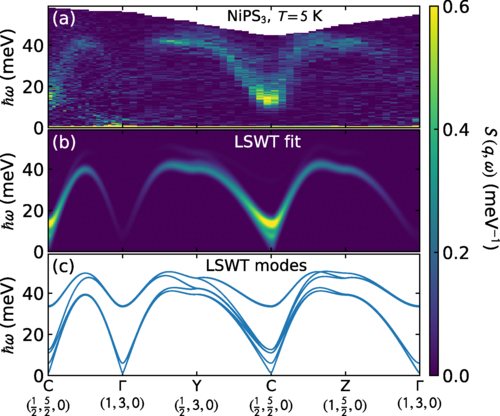Showing that electronic structure calculations provide an accurate model of a 2D magnetic material.
Impact: Modeling and the prediction of magnetic couplings are vital to codesign of materials. We predict the magnetic couplings in the optical quantum material NiPS3 and show these are highly accurate through measuring the spinwaves.



Above is the 2D structure of NiPS3. The top right shows the Wannier function overlaps that account for the magnetic couplings. The couplings depend sensitively on the electronic state of the material and, therefore, provide a rigorous test of the modeling of quantum properties. On the right, fits of the spinwaves show the remarkable accuracy of the modeling. Such modeling is essential for an in-depth understanding of topological superconductors and spin liquids in the QSC.
Summary: Using single-crystal inelastic neutron scattering, we measured the spin wave spectrum of the semiconducting honeycomb van der Waal antiferro-magnet NiPS3, and modeled the spin waves, extracting a magnetic Hamiltonian with rigorously defined uncertainty. We have also used first-principles calculations to model the magnetic exchange, and we find a spin exchange model which is consistent across multiple experimental probes. We also identify a strongly reduced static ordered moment and reduced low-energy intensity relative to the linear spin-wave calculations, signaling unexplained features in the magnetism, which requires going beyond the linear spin-wave approximation.
Contact: A.Scheie, scheie@lanl.gov
Focus areas: Materials
Institutions: Los Alamos National Laboratory, Oak Ridge National Laboratory, University of Tennessee, Seoul National University.
Citation: A. Scheie et al., ”Spin wave Hamiltonian and anomalous scattering in NiPS3”, Phys. Rev. B 108 , 104402 (2023). Selected Editor’s Choice.
Funding acknowledgment: Work mainly supported by the Quantum Science Center (QSC), a National Quantum Information Science Research Center of DOE, with contributions from the Leading Researcher Program of Korea’s National Research Foundation (Grant No. 2020R1A3B2079375), and the DOE LANL/LDRD Program and the Center for Non-Linear Studies